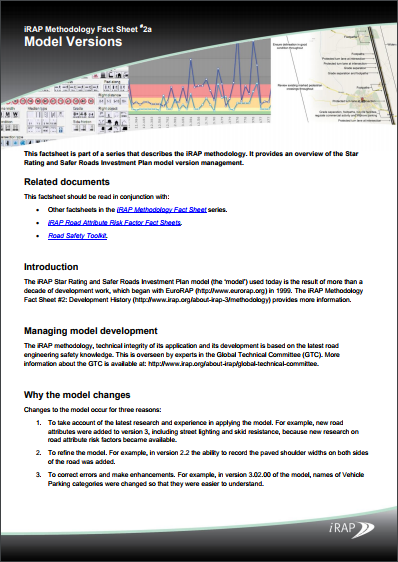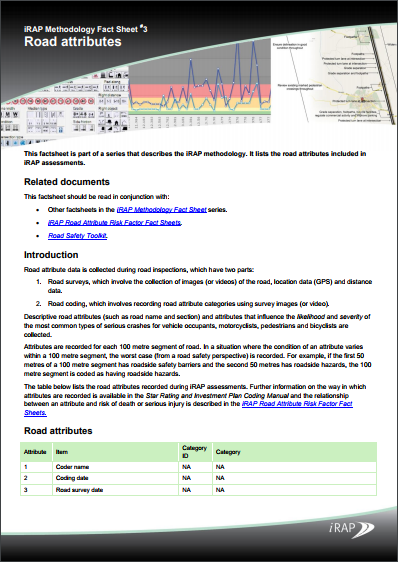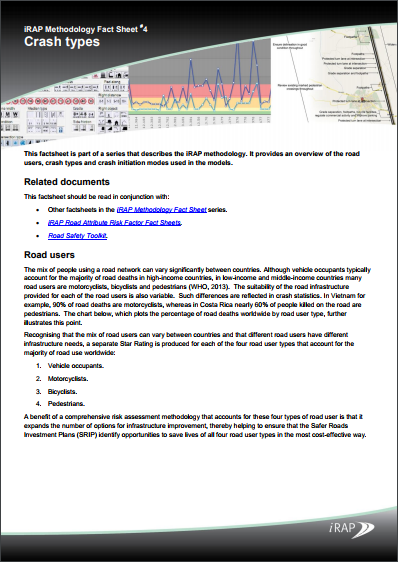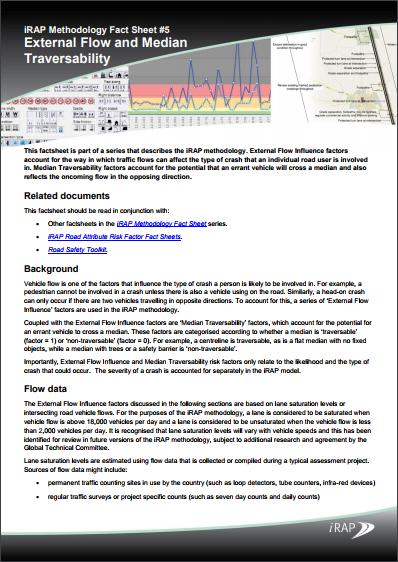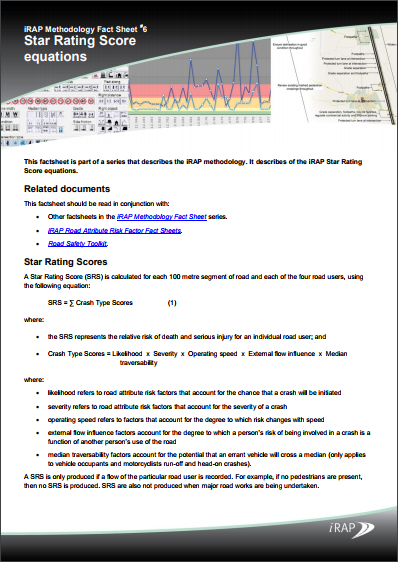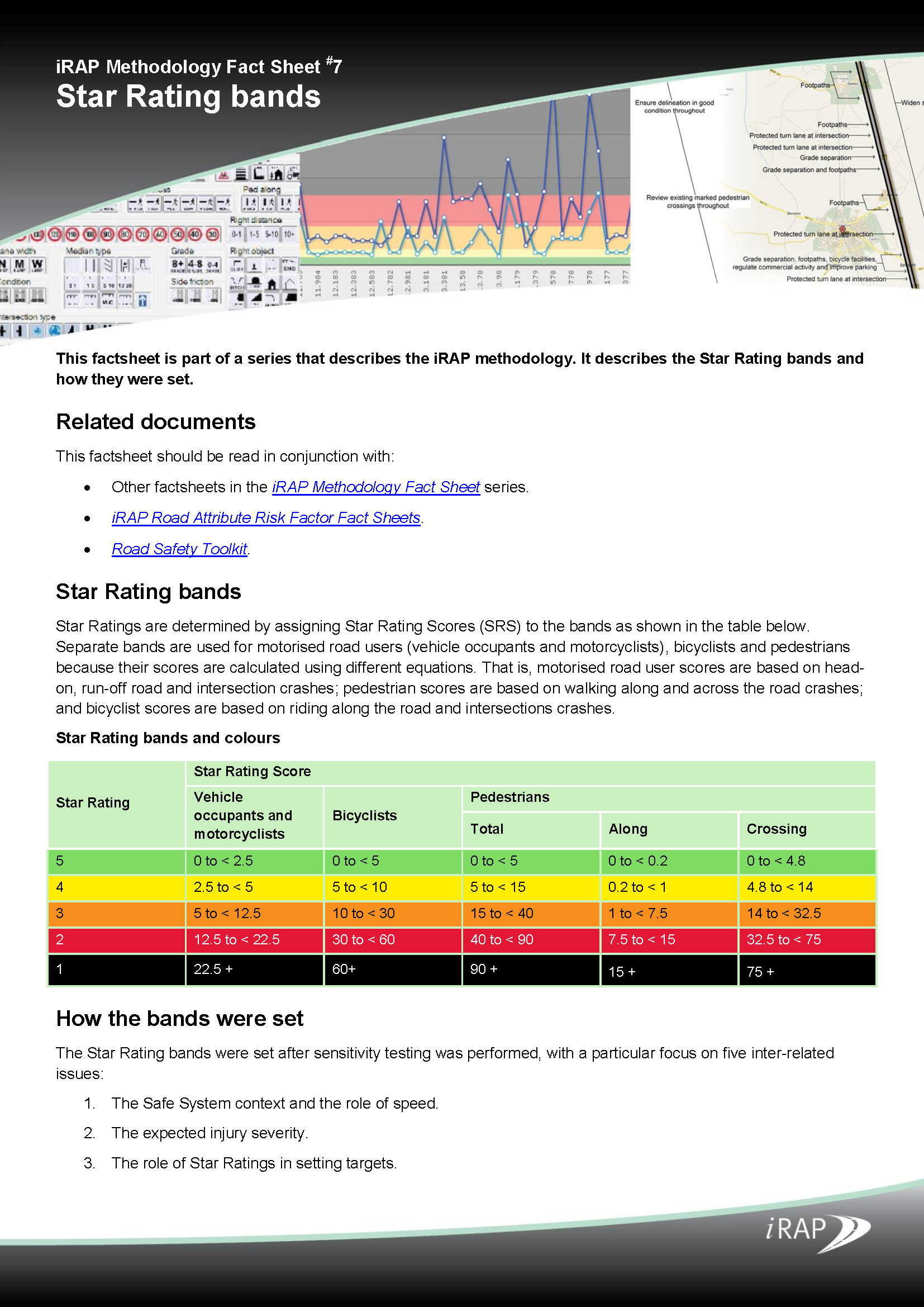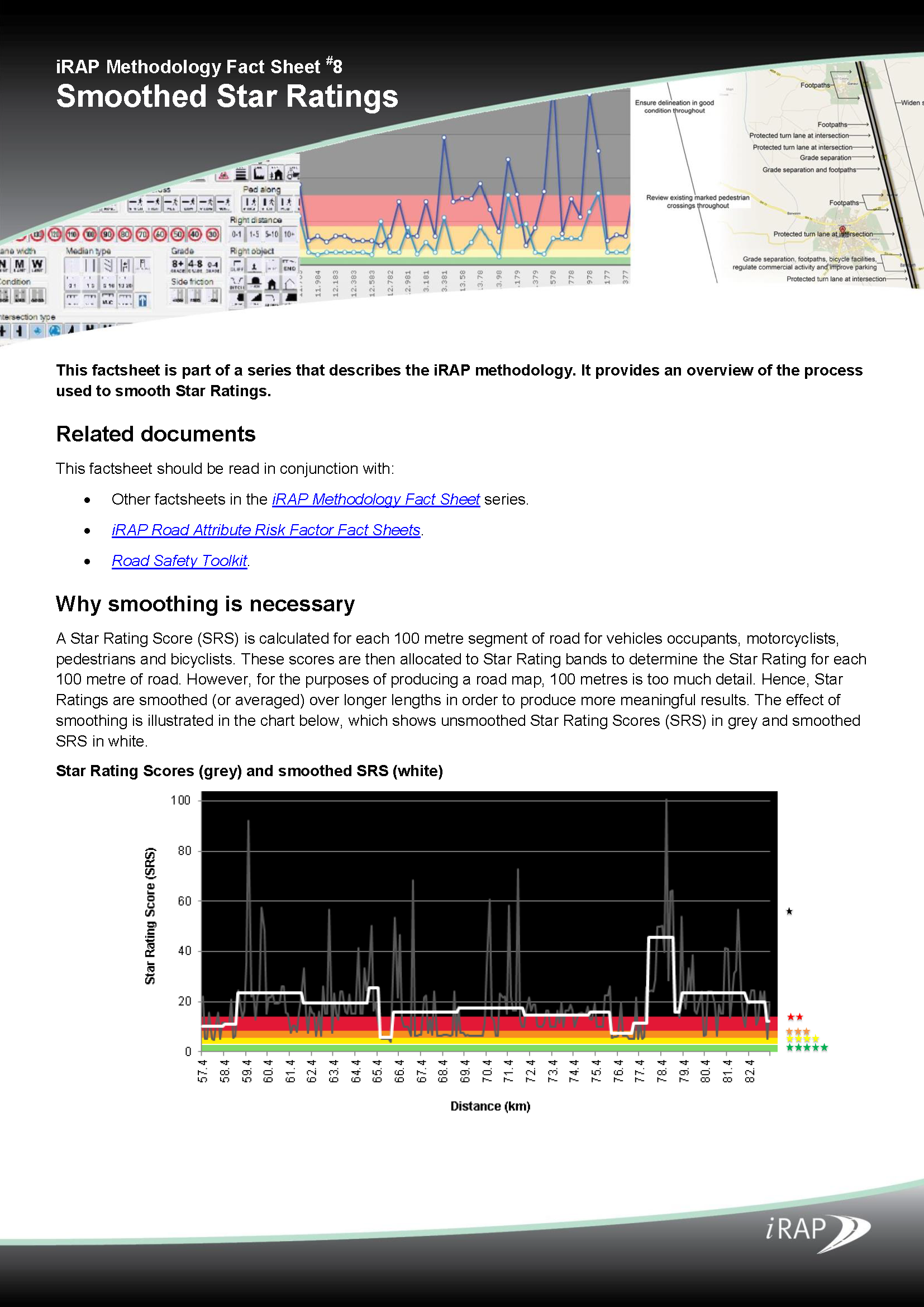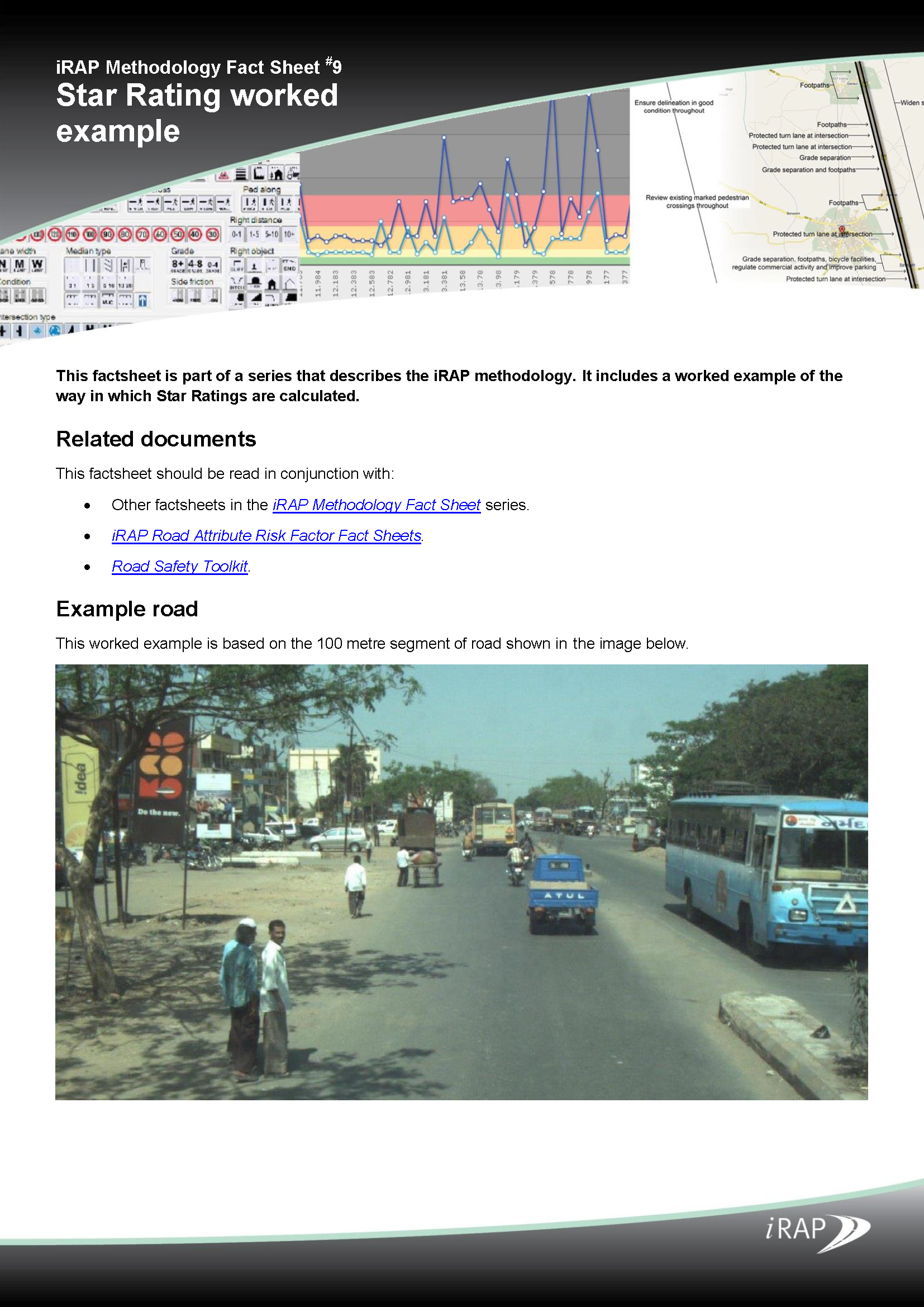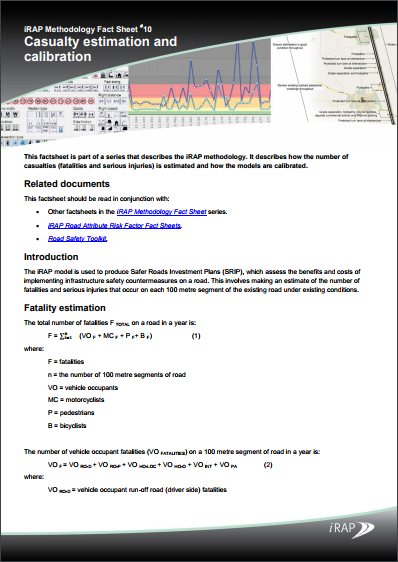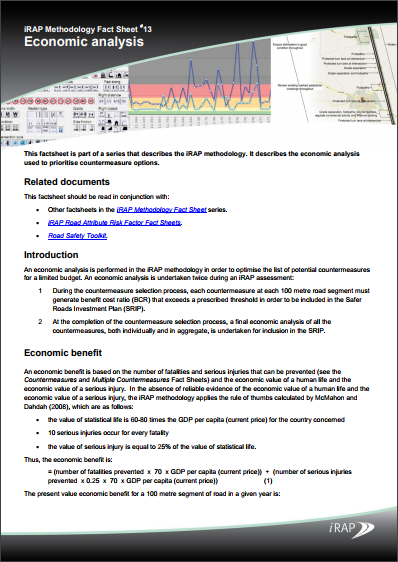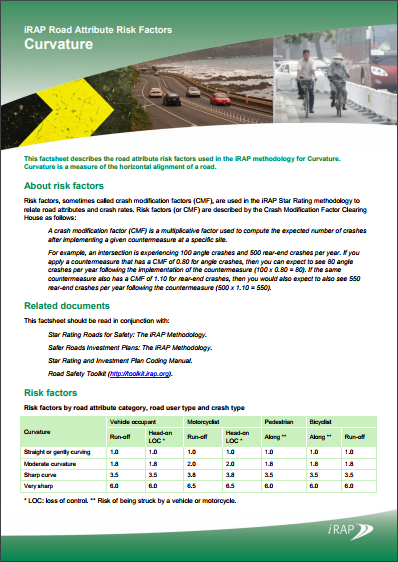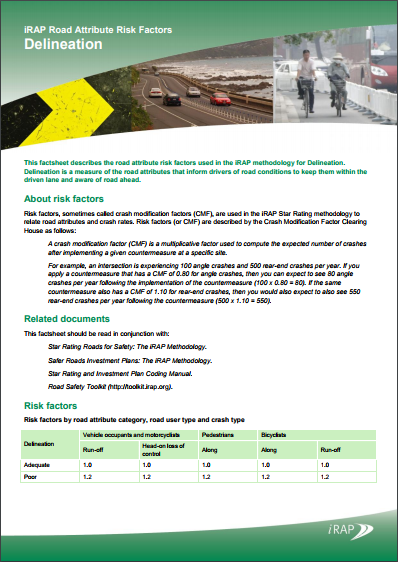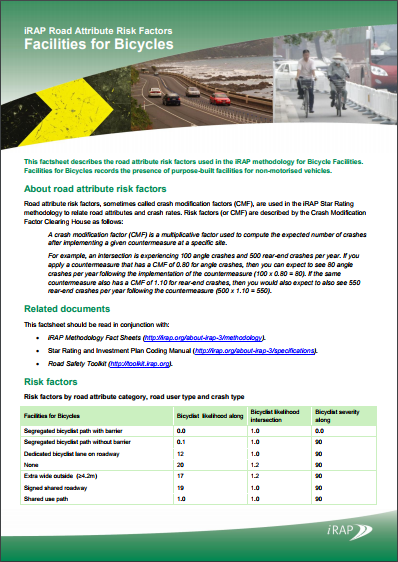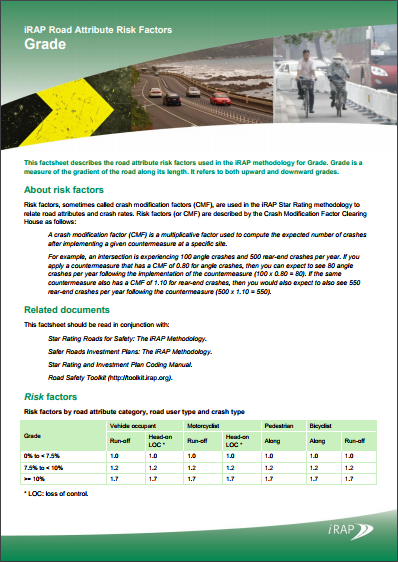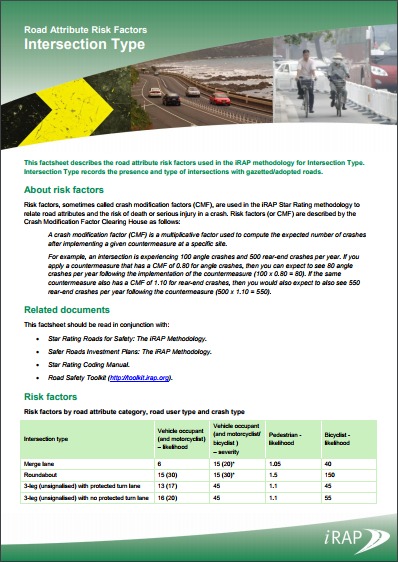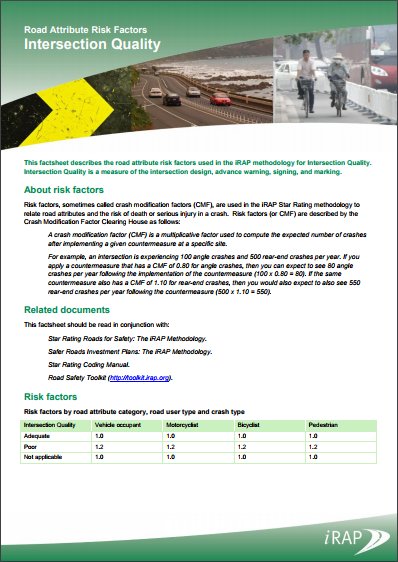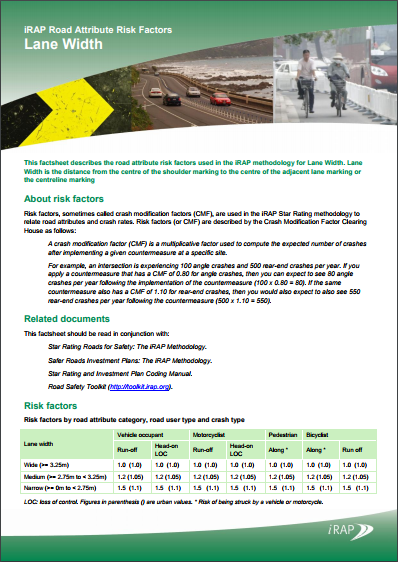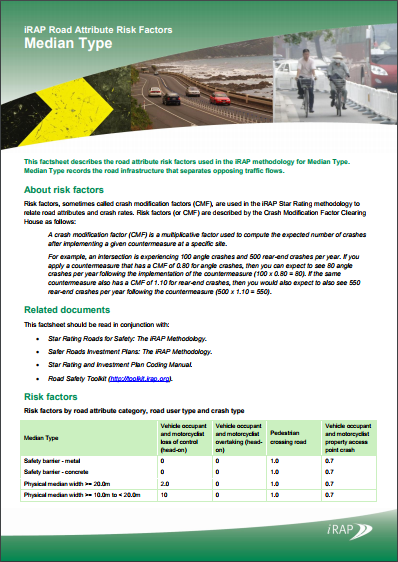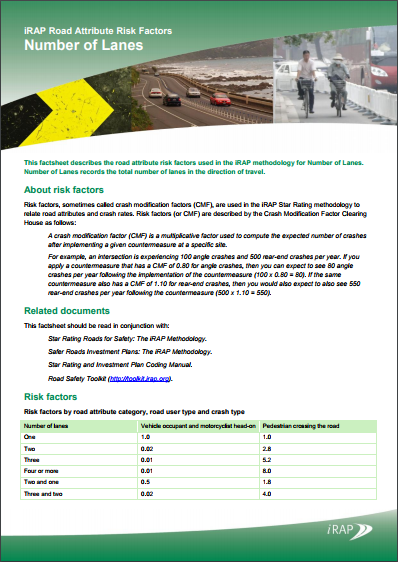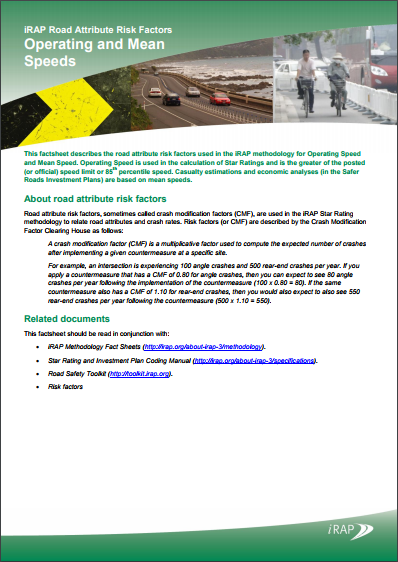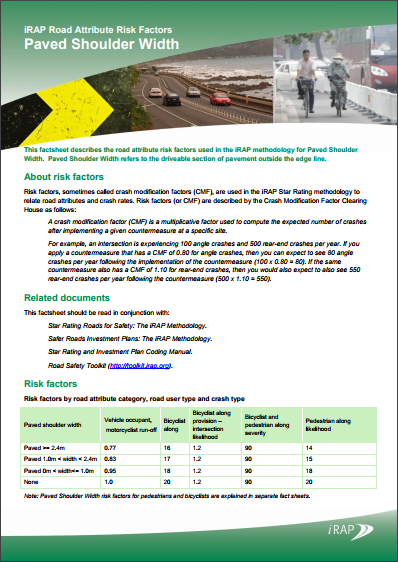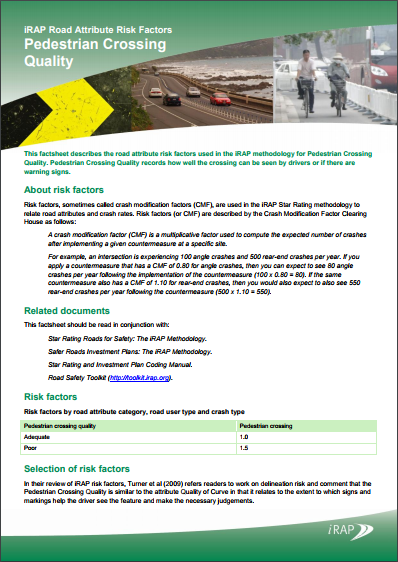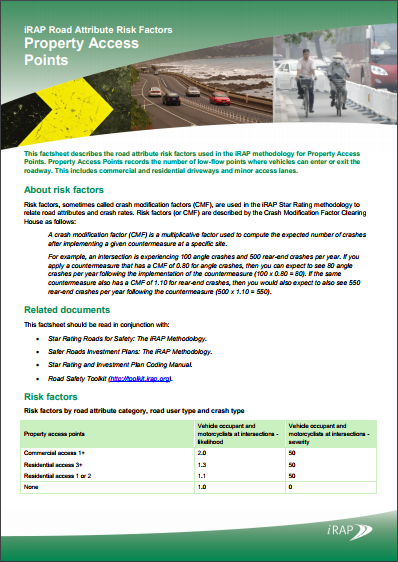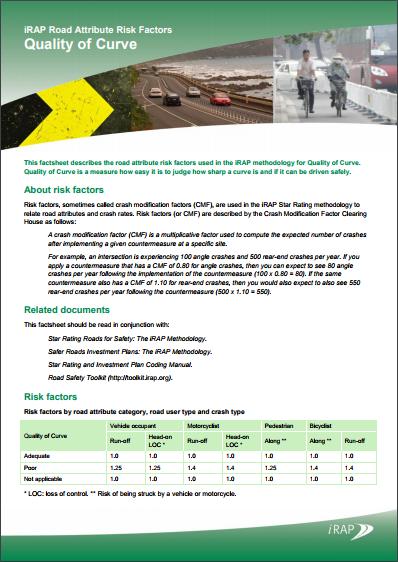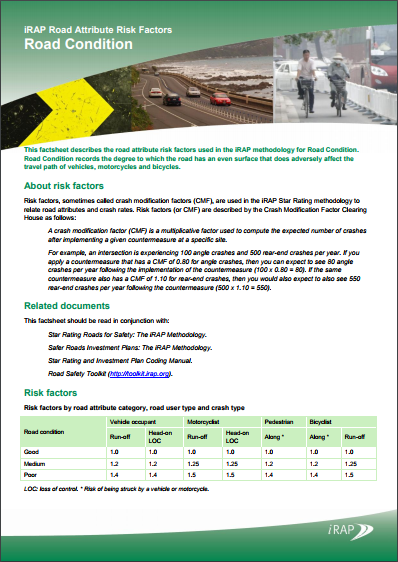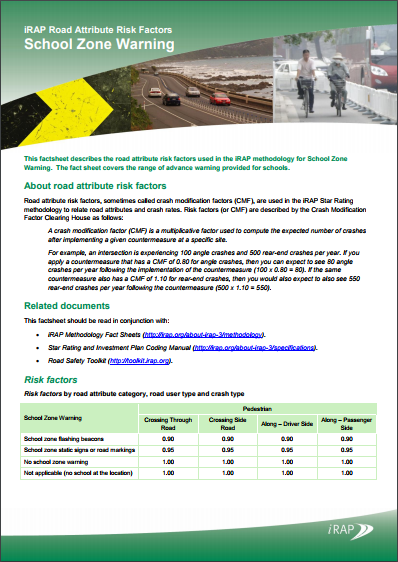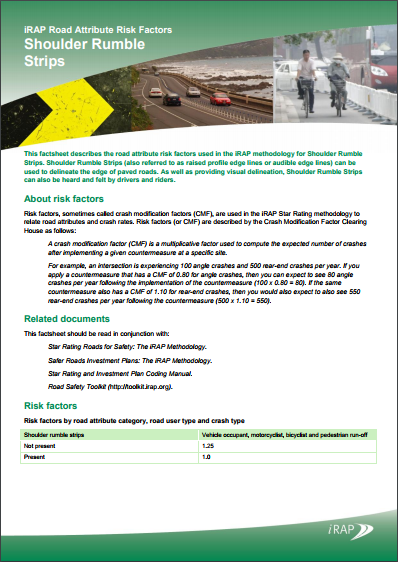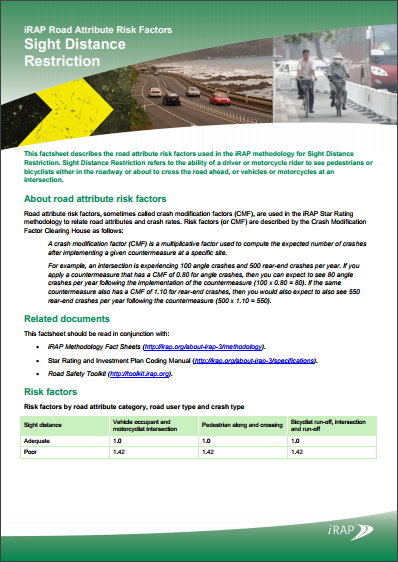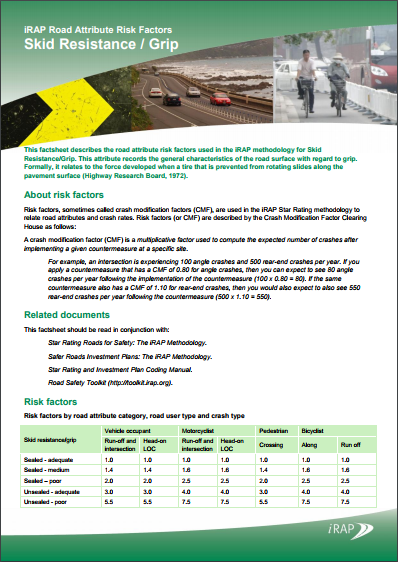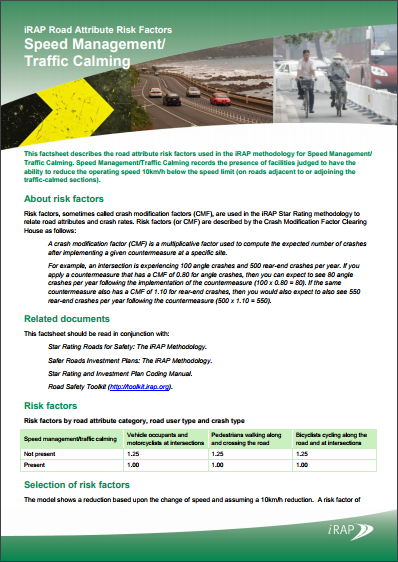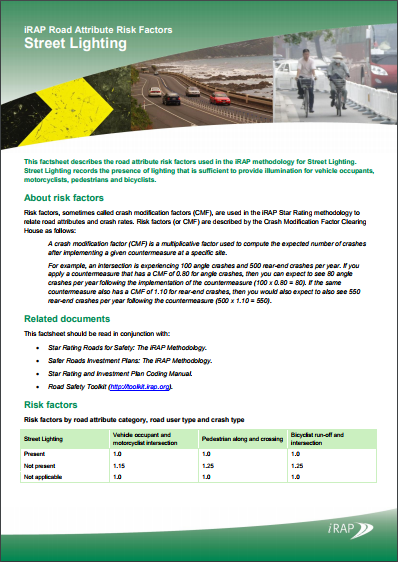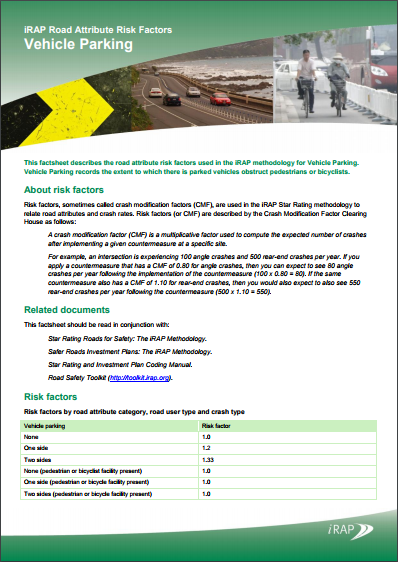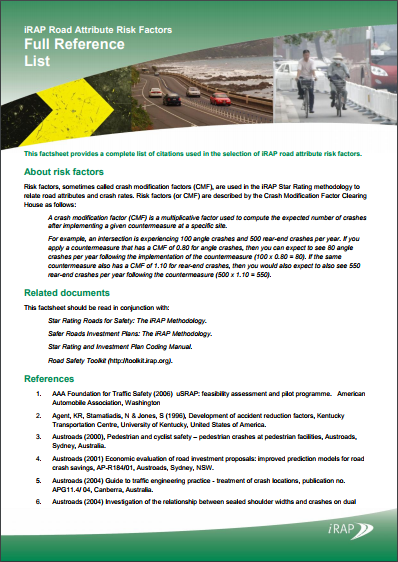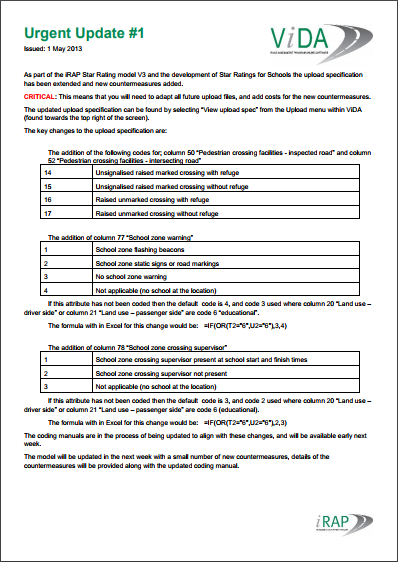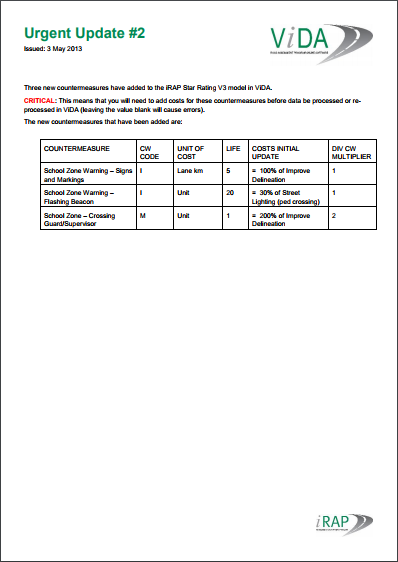iRAP Methodology fact sheets
The iRAP Methodology fact sheets answer many of the questions people have about the iRAP approach, covering topics such as crash types, Star Rating Score equations, model calibration and estimation of economic benefits and costs. These fact sheets complement the Road Attribute Risk Factor fact sheets.
The ‘iRAP Methodology’ fact sheets describe the Star Rating and Safer Roads Investment Plan methodologies, while the ‘iRAP Road Attribute Risk Factors’ fact sheets describe the risk factors used in the models.
Fact Sheet 1: Overview
Provides an overview of the Star Rating and Safer Roads Investment Plan processes and a list of fact sheets in the series.
Fact Sheet 2: Development History
Provides an overview of the Star Rating and Safer Roads Investment Plan development history.
Fact Sheet 2a: Model Versions
Provides an overview of Star Ratings and Safer Roads Investment Plan model version management.
Fact Sheet 3: Road Attributes
Lists the road attributes included in iRAP assessments.
Fact Sheet 4: Crash Types
Provides an overview of the road users, crash types and crash initiation modes used in the models.
Fact Sheet 5: External Flow & Median Traversability
Describes External Flow Influence factors.
Fact Sheet 6: Star Rating Score Equations
Describes the iRAP Star Rating Score equations.
Fact Sheet 7: Star Rating Bands
Describes the Star Rating bands and how they were set.
Fact Sheet 8: Smoothed Star Ratings
Provides an overview of the process used to smooth Star Ratings.
Fact Sheet 9: Star Rating Worked Example
Includes a worked example of the way in which Star Ratings are calculated.
Fact Sheet 10: Casualty Estimation & Calibration
Describes how the number of casualties is estimated and models are calibrated.
Fact Sheet 11: Countermeasures
Describes the road safety countermeasures used in the methodology.
Fact Sheet 12: Multiple Countermeasures
Describes how the effectiveness of a countermeasure is estimated when used with others.
Fact Sheet 13: Economic Analysis
Describes the economic analysis used to prioritise countermeasure options.
Fact Sheet 14: Star Ratings for Schools
Describes the background research and development associated with the Star Rating for Schools methodology.
Fact Sheet 15: Model Localisation
This factsheet provides an overview of the functionality provided to localise the Star Rating and Safer Roads Investment Plans.
iRAP Road Attribute Risk Factors
Fact Sheet: Centreline Rumble Strips
Describes the road attribute risk factors used in the iRAP methodology for Centreline Rumble Strips.
Fact Sheet: Curvature
Describes the road attribute risk factors used in the iRAP methodology for Curvature.
Fact Sheet: Delineation
Describes the road attribute risk factors used in the iRAP methodology for Delineation.
Fact Sheet: Facilities for Bicycles
Describes the road attribute risk factors used in the iRAP methodology for Facilities for Bicycles.
Fact Sheet: Facilities for Motorcycles
Describes the road attribute risk factors used in the iRAP methodology for Facilities for Motorcycles.
Fact Sheet: Grade
Describes the road attribute risk factors used in the iRAP methodology for Grade.
Fact Sheet: Intersection Type
Describes the road attribute risk factors used in the iRAP methodology for Intersection Type.
Fact Sheet: Intersection Channelisation
Describes the road attribute risk factors used in the iRAP methodology for Intersection Channelisation.
Fact Sheet: Intersection Quality
Describes the road attribute risk factors used in the iRAP methodology for Intersection Quality.
Fact Sheet: Lane Width
Describes the road attribute risk factors used in the iRAP methodology for Lane Width.
Fact Sheet: Median Type
Describes the road attribute risk factors used in the iRAP methodology for Median Type.
Fact Sheet: Number of Lanes
Describes the road attribute risk factors used in the iRAP methodology for Number of Lanes.
Fact Sheet: Operating Speed
Describes the road attribute risk factors used in the iRAP methodology for Operating Speed and Mean Speed.
Fact Sheet: Paved Shoulder Width
Describes the road attribute risk factors used in the iRAP methodology for Paved Shoulder Width.
Fact Sheet: Pedestrian Crossing Facilities
Describes the road attribute risk factors used in the iRAP methodology for Pedestrian Crossing Facilities.
Fact Sheet: Pedestrian Crossing Quality
Describes the road attribute risk factors used in the iRAP methodology for Pedestrian Crossing Quality.
Fact Sheet: Pedestrian Fencing
Describes the road attribute risk factors used in the iRAP methodology for Pedestrian Fencing.
Fact Sheet: Property Access Points
Describes the road attribute risk factors used in the iRAP methodology for Property Access Points.
Fact Sheet: Quality of Curve
Describes the road attribute risk factors used in the iRAP methodology for Quality of Curve.
Fact Sheet: Road Condition
Describes the road attribute risk factors used in the iRAP methodology for Road Condition.
Fact Sheet: Roadside Severity – Object
Describes the road attribute risk factors used in the iRAP methodology for Roadside Severity – Object.
Fact Sheet: Roadside Severity – Distance
Describes the road attribute risk factors used in the iRAP methodology for Roadside Severity – Distance.
Fact Sheet: School Zone Warning
Covers the range of advance warning provided for schools.
Fact Sheet: Service Road
Describes the road attribute risk factors used in the iRAP methodology for Service Road.
Fact Sheet: Shoulder Rumble Strips
Describes the road attribute risk factors used in the iRAP methodology for Shoulder Rumble Strips.
Fact Sheet: Sidewalk Provision
Describes the road attribute risk factors used in the iRAP methodology for Sidewalk Provision.
Fact Sheet: Sight Distance Restriction
Describes the road attribute risk factors used in the iRAP methodology for Sight Distance Restriction.
Fact Sheet: Skid Resistance / Grip
Describes the road attribute risk factors used in the iRAP methodology for Skid Resistance/Grip.
Fact Sheet: Speed Management / Traffic Calming
Describes the road attribute risk factors used in the iRAP methodology for Speed Management/ Traffic Calming.
Fact Sheet: Street Lighting
Describes the road attribute risk factors used in the iRAP methodology for Street Lighting.
Fact Sheet: Vehicle Parking
Describes the road attribute risk factors used in the iRAP methodology for Vehicle Parking.
Fact Sheet: Full Reference List
Provides a complete list of citations used in the selection of iRAP road attribute risk factors.




